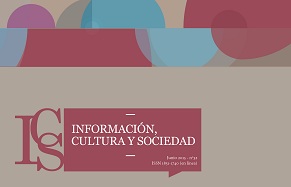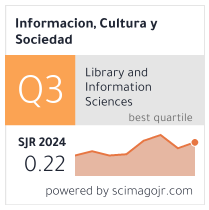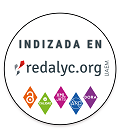Identification of the thematic dynamics present in the Journal Informacion, Cultura y Sociedad through Network Analysis
Abstract
Objective: Identify the research lines present in the Journal Información, Cultura y Sociedad (ICS), through network analysis, defining historical trends of interest, as well as opportunities to cover knowledge gaps. Methods: A cross - sectional descriptive study based on research published in ICS from its inception until 2016, considering as key elements the keywords, considering them as referring to the issue of publication. The evaluation had two approaches: number of occurrence of the nodes in the study period and analysis of power relations, scope and greater impact among them, applying Network Analysis (AR). Finally, it was comparatively evaluated the occurrence versus relations between nodes. Results: We reviewed 197 research papers, identifying 570 key words or research topics. The AR established that the majority of research papers have Argentina as the main topic, with a greater interest in issues directly related to librarianship, few of which correspond to cross-cutting themes and related to other environments. Conclusions: The greatest number of research topics in ICS are linked to library techniques and processes, so there is an opportunity to strengthen the content of the publication with transversal topics of an organizational type, such as knowledge management, information management Organizational, intelligence or business surveillance.Downloads
References
Arencibia, R. y J. A. Araujo. 2008. Visualización de la colaboración científica en la Revista CENIC Ciencias Químicas durante el período 1996-2005 mediante técnicas de análisis de redes sociales. En Revista CENIC. Ciencias Químicas. Vol. 39, no. 3, 161-166.
Assimakopoulos, D. 2007. Technological communities and networks: triggers and drivers for innovation. Londres: Routledge.
Ávila-Toscano, J. H. y A. Marenco-Escuderos. 2016. Producción bibliométrica y redes de cooperación en la revista Psicología desde el Caribe. En Psicología desde el Caribe. Vol. 33, no. 1, 66-80.
Borgatti S; M. Everett y L. Freeman. 2007. Ucinet for windows: Software for social network an alysis. Harvard: Analytic Technologies.
Buyl, T.; C. Boone y P. Matthyssens. 2013. The impact of the top management team’s knowledge diversity on organizational ambidexterity. A conceptual framework. En International Studies of Management & Organization. Vol. 42, no. 4, 8-26.
Cuellar, M.; H. Takeda; R. Vidgen y D. Truex. 2016. Ideational influence, connectedness, and venue representation: making an assessment of scholarly capital. En Journal of the Association for Information Systems. Vol. 17, no. 1, 1-28.
Dima, A. M. y S. Vasilache. 2015. Social network analysis for tacit knowledge management in universities. En Journal of Knowledge Economy. Vol. 6, no. 4, 856–864.
Duncan, R. B. 1976. The ambidextrous organization: Designing dual structures for innovation. New York: North Holland.
Filippini, R.; W. H. Güttel y A. Nosella. 2012. Ambidexterity and the evolution of knowledge management initiatives. En Journal of Business Research. Vol. 66, no. 3, 317-324.
Goyal, S. 2007. Connections: An introduction to the economics of networks. New Jersey: Princeton University Press.
Gravili, G. 2016. Social networks and intellectual capital: new forms for knowledge. In Proceedings of the European Conference on Intellectual Capital (2016 May 12-13: Venecia). p. 87-94.
Inkpen, AC. y E. Tsang. 2016. Reflections on the 2015 decade award--social capital, networks, and knowledge transfer: an emergent stream of research. En Academy of Management Review. Vol. 41, no. 4, 573-588.
Junni, P.; R. M. Sarala; V. Taras y S. Y. Tarba. 2013. Organizational ambidexterity and performance: a meta-analysis. En The Academy of Management Perspectives. Vol. 27, no. 4, 299-312.
Koseoglu, M. 2016. Mapping the institutional collaboration network of strategic management research: 1980–2014. En Scientometrics. Vol. 36, no. 4, 212-219.
Kretschmer, H. y I. Aguillo. 2004. Visibility of collaboration on the Web. En Scientometrics. Vol 61, no. 3, 405–26.
Li, L, et al. 2016. The Global Research Collaboration of Network Meta-Analysis: A Social Network Analysis. En PLoS One. Vol. 11, no. 9, 1-19.
Ling, JR. 2009. Social network analysis: Theory, method and application. Beijing: Normal University Press.
Liu, J. 2004. An introduction to school network analysis. Beijing: Social Science Documentation Publishing House.
Ma, S.; C. Jiao y M. Zhang. 2011. Application of social network analysis in psychology. En Advances in Psychological Science. Vol. 19, no. 5, 755–64.
Martínez, M. y E. Wills. 2013. Creación de conocimiento en management: influencia de las características relacionales y estructurales de las redes sociales. En Cuadernos de Administración. Vol. 26, no. 46, 37-59.
Melo, H. y B. Kramer. 2013. Brazilian administration review: uma análise do perfil da produção acadêmica científica no período de 2004 a 2012 sob a ótica da rede social e da bibliometría. En Revista de Ciências da Administração. Vol. 15, no. 37, 66-81.
Molina, J. L. 2009. Panorama de la investigación en redes sociales. En REDES- Revista hispana para el análisis de redes sociales. Vol. 17, no. 11, 235-256.
Montoya, I; A. Valencia y A. Montoya. 2016. Mapeo del campo de conocimiento en intenciones emprendedoras mediante el análisis de redes sociales de conocimiento. En Ingeniare. Revista chilena de ingeniería. Vol. 24, no. 2, 337-350.
Morescalchia, A. et al. 2015. The evolution of networks of innovators within and across borders: Evidence from patent data. En Research Policy. Vol. 44, no. 3, 651-668.
Osca-Lluch, J. 2010. Aplicación del análisis de redes al estudio de la investigación española de historia de la ciencia. En REDES - Revista hispana para el análisis de redes sociales. Vol. 19, no. 1, 114-135.
Repiso, R.; D. Torres y E. Delgado. 2011. Análisis bibliométrico y de redes sociales en tesis doctorales españolas sobre televisión (1976/2007). En Comunicar. Vol. 18, no. 37, 151-159.
Russell, JM.; M. J. Madera y S. Ainsworth. 2009. El análisis de redes en el estudio de la colaboración científica. En REDES- Revista hispana para el análisis de redes sociales. Vol. 17, no. 2, 39-47.
Sanz-Valero, J.; V. T. Casterá y C. Wanden-Berghe. 2014. Estudio bibliométrico de la producción científica publicada por la Revista Panamericana de Salud Pública/ Pan American Journal of Public Health en el período de 1997 a 2012. En Revista Panamericana de Salud Publica. Vol. 35, no. 2, 81-88.
Sone, K. et al. 2014. Relationship between active information exchange and the quality of life (QOL) of women living in Lao People’s Democratic Republic. En Southeast Asian Journal of Tropical Medicine And Public Health. Vol. 45, no. 4, 956-966.
Stoddart, S. y M. K. Siddiqui. 2013. Social network analysis of authorship networks and the identification of expert advisors. En Value in Health. Vol. 16, no. 7, 614-614.
Valente T. 1995. Network models of the diffusion of innovations. New Jersey: Hampton Press.
Wu, Y. y Z. Duan. 2015. Social network analysis of international scientific collaboration on psychiatry research. En International Journal of Mental Health Systems. Vol. 9, no. 1, 1-22.
Ya-Rui, A. y M. Ding. 2016. Modeling the evolution of collaboration network and knowledge network and their effects on knowledge flow through social network analysis. En Journal of Digital Information Management. Vol. 14, no. 4, 246-254.
Authors publishing in this journal acknowledge the conditions below:
- Authors retain the copyright of their work while they transfer the right of the first publishing to the journal, under the Creative Commons Attribution-ShareAlike 4.0 International (CC BY-SA 4.0) Licence, which allows third parties to reproduce them under the condition that express mention is given to the author and to its original publication in the journal.
- Authors may enter into other contractual and independent arrangements for the non-exclusive distribution of the version of the article published in this journal (for instance, it can be published in an institutional repository or in a book). In any case, an express mention should be given to its first publication in the journal.
- It is permitted and encouraged to publish online the articles (for example, on institutional or personal pages).


























